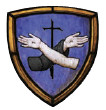Reliquary
The Friary Church contains a reliquary of the Roman boy-martyr, St. Adjutor. The casket displays a wax figure of the saint in which is enclosed his relic, and also a phial of his blood. The casket originally lay beneath the Altar of St. Francis; nowadays it is on display at the end of the church.
Arrival of the Reliquary into Wexford
In his book The History and Traditions of Wexford Friary Fr. Anthanatius Giblin OFM writes:
“Beneath this altar lies the famed Reliquary of St. Adjutor, Martyr…It [the Reliquary] contains a wax image within which are enclosed the Sacred Remains of St. Adjutor. The Reliquary contains also a phial of the Martyr’s blood. As testified in the Reliquary’s Authenticate, dated the 20th April, 1856, and preserved in the Archives of Wexford Friary, the Sacred Remains of St. Adjutor and the phial of his blood were identified and taken from the Cemetery of St. Praetextatis on the 25th April, 1850, at the command of Pope [now Blessed] Pius IX, and presented to Mr. Richard Devereux, K.S.G., of Rocklands, Wexford, in recognition of his active Catholicism. A merchant, who had acquired vast wealth and influence, it was he who put his fleet at the service of the starving poor of the town, securing for them supplies of wheat and corn from Galatz, during the Great Famine of 1847; he is still remembered in Wexford for his widespread charitable activities. It was because of his generosity and thoughtfulness that Wexford Friary acquired this Reliquary – being solemnly transferred from Rocklands, the Devereux home, where it had been for some time, to the Friary Church. On the 16th March, 1883, Mr. Devereux died and was buried in the Friary Graveyard.”
Incidentally, this was not the first time the remains of a Roman martyr had come to Ireland: Pope Gregory XVI presented the relics of St. Valentine to the Irish Carmelite Order, and in 1836 these were brought to Ireland and enshrined in the Carmelite Church in Whitefriar Street, Dublin.
Who was St. Adjutor?
We know very little about the life and death of St. Adjutor. He was probably killed in the 3rd century A. D., an era when many Christians in Rome were put to death. The palm in his hand is a symbol of martyrdom, indicating that he died for the Faith. Judging by the size of the waxen figure, he was probably quite young when he died.
According to local tradition in Wexford he was killed by his father, a pagan, with a blow of a hatchet to the head. As to the rest of the details surrounding his death, we are not certain. One version of the story is that Adjutor’s father had learned that he had attended the Confirmation of a Christian friend. Another version is that Adjutor was forbidden to attend Mass by his father, but he went anyway and received a severe beating from his father; the second time his father put him into a barrel of boiling oil, but he survived saying that a woman in blue rescued him; he continued to attend Mass and the last time his father killed him with a hatchet blow.
Intercession
St. Adjutor is popularly known in the area as ‘the little saint’. He is often invoked for a happy death.
EXTRACT FROM THE PEOPLE NEWSPAPER, SATURDAY, 2nd JUNE, 1866
CEREMONY AT THE FRANCISCAN CHURCH, WEXFORD ST. ADJUTOR, MARTYR
“A grand religious ceremony will take place in the Franciscan Church on Sunday, 15th July next. Rev. Dr. Devereux of Wexford, son of Mr. Thomas Devereux, Esq., ex-M.P., of Rocklands House, has presented to the Franciscan Church a precious relic, the entire body of a saint, a holy martyr named Adjutor, who died for the Faith at the tender age of about 14 years.
The body was taken from the cemetery of St. Protictatis and is authorised by Our Holy Father, the Pope, to be exposed for the veneration of the faithful in any church to which Dr. Devereux would bestow it. The shrine in which the body is enclosed is at present in the private chapel of Rocklands House. It will be conveyed to the Franciscan Church and borne in solemn procession around the chapel yard by the clergy and people.
The ceremony will be presided over by Dr. Furlong, and after the procession the saint’s body will be placed under the Altar of St. Francis where it will remain forever as a monument of the piety and zeal of Dr. Devereux. The Franciscan Fathers and the people of Wexford owe a debt of deep gratitude to Rev. Dr. Devereux for this rare and splendid present to the Church. The ceremonies will be conducted in the most gorgeous style. The music for the grand High Mass will be for the first time in Wexford that Karl Maria von Weber’s the great composition in G. This will be rendered by a full choir under the direction of Mr. T. J. Lyons. The sermon on the occasion will be preached by Rev. Sir Christopher Bellew, Bart.”

